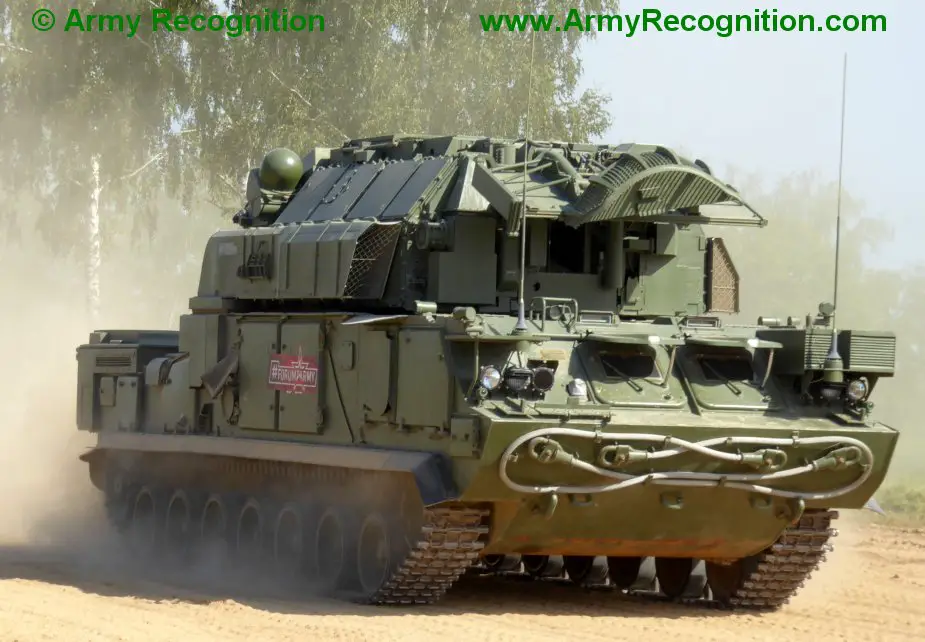Russian ground forces receive latest Tor-M2 missile air defense system
Air defense units of the Russian ground forces are receiving the latest close-range Tor-M2 antiaircraft weapons. One unit can control the airspace in the defense area of a regiment or brigade. It is the only weapon in the world capable of firing in motion, Chief Designer of Vympel Bureau of Tactical Missiles Corporation which produced 9M338 missile for Tor-M2 Viktor Yeletsky told the Izvestia daily.

Tor-M2 demonstrated at Army-2018 near Kubinka (Picture source: Army Recognition)
The Tor system was succeeded by Tor-M1 and now by Tor-M2. The main mission is to defend first echelon troops. Tor-M2 is equipped with software which fully meets modern combat requirements. It can simultaneously fire at four targets while the first Tor could strike only at one target.
Tor-M2 covers a longer frontline than predecessors. It is the only antiaircraft weapon in the world that can operate in motion. Previously, an air defense battalion or regiment had to make a stopover to fire at a target and then proceed. Now the weapon can fire in motion. It guarantees destruction of any aircraft or drone, precision munitions, including cruise missiles and gliding bombs. The strike precision allowed abandoning the practice of attacking a target with two missiles. Tor operates by one target - one missile principle.
The ideology of battle air defense emerged yet in the early 1960s and called to engage various weapons at various defense lines. S-300 is in charge of the first line with a range of over a hundred kilometers. Buk operates on the medium line and destroys targets at a range of 50-70 kilometers. Tor-M2 attacks targets which break through the first two lines. The range of 9M338K missile allows Tor-M2 to defend 20 kilometers of a frontline. The weapon can intercept small maneuvering and speed targets. It suffices to engage one vehicle instead of the previous two.
The designers doubled Tor-M2’s number of missiles to 16 9M338K missiles. In modern conflict, nobody predicts a fight with solo targets. In rare cases, it can be a reconnaissance aircraft or a drone. The air defense will have mostly to encounter massive raids. In 2016, five Saman targets were launched in turn during Tor-M2DT (Arctic) trials. They were all destroyed by five missiles and three by a direct hit.
High characteristics are due to missile aerodynamics. The designers rejected big carrying surfaces. The missile can enter bigger angles of attack than predecessors. The size decreased and the missiles obtained a possibility to destroy highly maneuverable targets.
The designers also dropped the catapult launch to decrease weight and increase reliability. Tor-M2 missile leaves the launcher with the help of reduced-weight gas generators which operate for a short time. They also deflect the missile.
It is hard to destroy a gliding bomb completely by a hit. The bomb has a thick hull which is difficult to pierce by a light warhead. Even two missiles will not fulfill the mission. It is necessary to destroy the command block. There is a system that can hit the unit and destroy it or make inoperative. Some foreign analogs are close to Tor-M2 parameters and characteristics. But the Russian weapon remains unprecedented by its total capabilities. French engineers have similar designs, but they are at the trial stage. The advantage of the project is infrared homing warhead, but it radically increases the cost of the weapon.
Tor designers have not been instructed to install homing systems, but the design allows rapidly mounting an infrared homing warhead, Chief Designer of Vympel Bureau Viktor Yeletsky told the Izvestia daily.
© Copyright 2019 TASS / Army Recognition Group SPRL . All rights reserved. This material may not be published, broadcast, rewritten or redistributed.


























